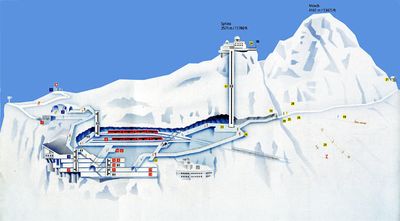Switzerland
A Technological Pastoral

In 1992, Stanislaus von Moos coined the expression «Erschliessungsfieber» to describe the rapid development of infrastructures in late nineteenth-century Switzerland that not only fundamentally defined a new territory—through electricity, gas, and water supplies—but also created a new aesthetic vision of that territory (VON MOOS 1992: 91–132). However, this transformation, while studied within many fields, has failed to impact the design disciplines and professionals responsible for producing this territory. Neither is it understood the way in which cultural aesthetic values interact with these technological drivers. In Switzerland, the oft-employed opposition of a ‘pastoral’ pre-industrial or natural landscape to a ‘technological’ post-industrial built environment continues to motivate the way in which architecture is designed and written about. Switzerland: A Technological Pastoral therefore aims to identify and visualise the specific ways in which the interaction between infrastructural technologies and aesthetic values– on the part of designers but also the general public–affect how the built environment is analysed, designed and used.
In understanding how technological developments have interacted with pastoral ideals in order to co-produce the post- war environment, Switzerland: A Technological Pastoral will deploy interdisciplinary perspectives to create a substantial contribution to a changing field of architectural design that is beginning to address territory, within and beyond Switzerland. It will draw upon literature from the variety of fields that have addressed the subject of infrastructure, and in particular histories of Swiss infrastructural development, and combine this with empirical site investigations and archival research. The research will be structured as four case studies carried out through individual doctoral projects. Each case study tackles a type of infrastructure that has shaped the Swiss territory over the last 150 years to analyse how the designing of flows—of information (e.g. Federal Administration in Bern), tourists (e.g. Jungfraujoch), commodities (e.g. Logistic-Landscape around Härkingen, Neuendorf, Egerkingen, and Oftringen), and water (e.g. Valley of Vals)—produce certain hybridised environments consisting of the built and the unbuilt. The case studies will be assessed at a full range of scales from the territory, to individual buildings, to the technological apparatuses inside of buildings, all of which are connected—often invisibly—through infrastructure. In addition to the four doctoral dissertations, the output will include peer-reviewed research papers, and three workshops, all of which will frame a resulting project Atlas. This Atlas will be an openly accessible and interactive platform, and ultimately a print publication, which will synthesise source material in order to share it amongst the team’s researchers and simultaneously visualise this data in a way that makes it practically available for designers and scholars.
Infrastructure, and the flows of people and materials that it channels, has been the object of study in many fields, from architecture and urbanism, to the history of technology and urban studies (in particular, science and technology studies or bottom-up assemblage perspectives). This study hopes to extend existing scholarship in four ways. Firstly, the aims of previous researchers have largely been to describe the city, rather than the relationship between architecture and a territory that extends well beyond the urban limit. Additionally, most of this scholarship has not addressed the design field. Nor has it been able to visually synthesise results in a way that makes them available to the practitioners who are charged with designing, building, and planning for, the built territory. Finally, this project is the first in-depth study of its kind to focus on Switzerland. The metaphorical title Technological Pastoral proposes thus to capture the central concern of the study: the hypothesis that pastoral ideals inherited from the past tend to obscure the current technological, urban reality when considering the designed environment in Switzerland.
A project in collaboration with the Institute for the History and Theory of Architecture (gta), Prof. Laurent Stalder.